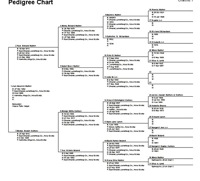Difference between revisions of "Pedigree"
(Created page with 'File:lighterstill.jpgright|frame ==Origin== [http://nordan.daynal.org/wiki/index.php?title=English#ca._1100-1500_.09THE_MIDDLE_ENGLISH_PERIOD Midd...') |
m (Text replacement - "http://" to "https://") |
||
| (One intermediate revision by the same user not shown) | |||
| Line 2: | Line 2: | ||
==Origin== | ==Origin== | ||
| − | [ | + | [https://nordan.daynal.org/wiki/index.php?title=English#ca._1100-1500_.09THE_MIDDLE_ENGLISH_PERIOD Middle English] ''pedegru'', from Anglo-French ''pé de grue'', [[literally]], crane's foot; from the shape made by the lines of a genealogical chart |
| − | *[ | + | *[https://en.wikipedia.org/wiki/15th_century 15th Century] |
==Definitions== | ==Definitions== | ||
*1: a register recording a line of [[ancestors]] | *1: a register recording a line of [[ancestors]] | ||
| Line 11: | Line 11: | ||
:b : the recorded [[purity]] of breed of an [[individual]] or strain | :b : the recorded [[purity]] of breed of an [[individual]] or strain | ||
==Description== | ==Description== | ||
| − | A '''pedigree''' chart is a [[diagram]] that shows the occurrence and [[appearance]] or [ | + | A '''pedigree''' chart is a [[diagram]] that shows the occurrence and [[appearance]] or [https://en.wikipedia.org/wiki/Phenotype phenotypes] of a particular gene or [[organism]] and its [[ancestors]] from one [[generation]] to the next, most commonly humans, show [https://en.wikipedia.org/wiki/Dog dogs], and race horses. The [[word]] ''pedigree'' is a corruption of the French "pied de grue" or crane's foot, because the typical lines and split lines (each split leading to [[different]] offspring of the one parent line) resemble the thin leg and foot of a crane. |
==In human genealogy== | ==In human genealogy== | ||
| − | In England and Wales pedigrees are officially recorded in the [ | + | In England and Wales pedigrees are officially recorded in the [https://en.wikipedia.org/wiki/College_of_Arms College of Arms], which has records going back to the [https://en.wikipedia.org/wiki/Middle_Ages Middle Ages], including pedigrees collected during roving [[inquiries]] by its [[heralds]] during the sixteenth and seventeenth centuries. The [[purpose]] of these [https://en.wikipedia.org/wiki/Heraldic_visitation heraldic visitations] was to register and regulate the use of [https://en.wikipedia.org/wiki/Coats_of_arms coats of arms]. Those who claimed the right to bear arms had to provide [[proof]] either of a grant of arms to them by the College, or of descent from an [[ancestor]] entitled to arms. It was for this [[reason]] that pedigrees were recorded by the visitations. Pedigrees continue to be registered at the College of Arms and kept up to date on a [[voluntary]] basis but they are not accessible to the general [[public]] without payment of a fee. |
| − | More visible, therefore, are the pedigrees recorded in published works, such as [ | + | More visible, therefore, are the pedigrees recorded in published works, such as [https://en.wikipedia.org/wiki/Burke%27s_Peerage Burke's Peerage] and Burke's [https://en.wikipedia.org/wiki/Landed_gentry Landed Gentry] in the United Kingdom and, in continental Europe by the [https://en.wikipedia.org/wiki/Almanach_de_Gotha Almanach de Gotha]. |
==In animal husbandry== | ==In animal husbandry== | ||
| − | In the [[practice]] of [ | + | In the [[practice]] of [https://en.wikipedia.org/wiki/Selective_breeding selective breeding] of animals, particularly in [https://en.wikipedia.org/wiki/Animal_fancy animal fancy] and [https://en.wikipedia.org/wiki/Livestock livestock], including horses, pedigree charts are used to track the [[ancestry]] of animals and assist in the [[planning]] of suitable breeding [[programs]] to enhance desirable [[traits]]. [https://en.wikipedia.org/wiki/Breed_registry Breed registries] are formed and are [[dedicated]] to the accurate tracking of pedigrees and maintaining accurate [[records]] of [[birth]], [[death]] and identifying characteristics of each registered animal. |
[[Category: History]] | [[Category: History]] | ||
[[Category: Biology]] | [[Category: Biology]] | ||
Latest revision as of 01:50, 13 December 2020
Origin
Middle English pedegru, from Anglo-French pé de grue, literally, crane's foot; from the shape made by the lines of a genealogical chart
Definitions
- 3a : a distinguished ancestry
- b : the recorded purity of breed of an individual or strain
Description
A pedigree chart is a diagram that shows the occurrence and appearance or phenotypes of a particular gene or organism and its ancestors from one generation to the next, most commonly humans, show dogs, and race horses. The word pedigree is a corruption of the French "pied de grue" or crane's foot, because the typical lines and split lines (each split leading to different offspring of the one parent line) resemble the thin leg and foot of a crane.
In human genealogy
In England and Wales pedigrees are officially recorded in the College of Arms, which has records going back to the Middle Ages, including pedigrees collected during roving inquiries by its heralds during the sixteenth and seventeenth centuries. The purpose of these heraldic visitations was to register and regulate the use of coats of arms. Those who claimed the right to bear arms had to provide proof either of a grant of arms to them by the College, or of descent from an ancestor entitled to arms. It was for this reason that pedigrees were recorded by the visitations. Pedigrees continue to be registered at the College of Arms and kept up to date on a voluntary basis but they are not accessible to the general public without payment of a fee.
More visible, therefore, are the pedigrees recorded in published works, such as Burke's Peerage and Burke's Landed Gentry in the United Kingdom and, in continental Europe by the Almanach de Gotha.
In animal husbandry
In the practice of selective breeding of animals, particularly in animal fancy and livestock, including horses, pedigree charts are used to track the ancestry of animals and assist in the planning of suitable breeding programs to enhance desirable traits. Breed registries are formed and are dedicated to the accurate tracking of pedigrees and maintaining accurate records of birth, death and identifying characteristics of each registered animal.
